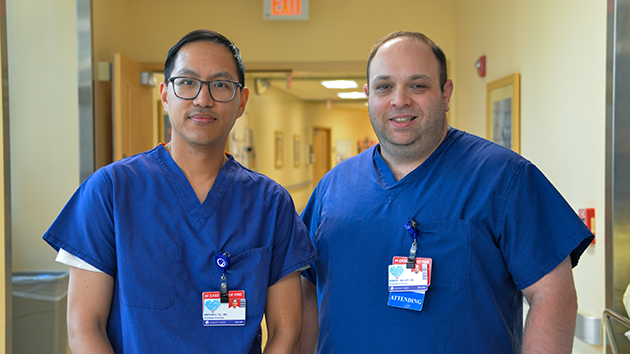Team Effort Restores Patient's Hearing in Regional First

At first, Ian Yorks thought his loss of balance was just one more complication in a series of setbacks following months of hospitalization and rehabilitation after a near fatal bout of Covid-19. But when he suddenly lost hearing in his left ear, it was time for further tests.
Yorks, 46, of Cobleskill, was referred to Albany Medical Center’s Department of Otolaryngology (Ear, Nose, Throat).
“Any time a patient presents with unilateral (one-sided) hearing loss, we’re trained to order an MRI,” said otolaryngologist Nathan Tu, MD.
Yorks’ MRI revealed he had an acoustic neuroma (also known as a vestibular schwannoma), a rare but benign tumor that develops on the main nerve leading from the inner ear to the brain—often impacting balance and hearing. Although they are small and usually slow growing, these tumors can grow large enough to impact the brain and vital functions. Treatments vary according to the tumor’s size, location, and whether it is causing complications, as well as the patient’s age and overall health. Many patients will only require regular monitoring, while some may need radiation or surgery. Unfortunately, many patients will not regain their hearing.
Although the tumor was more unwelcome news for Yorks, he was in the right place. Albany Medical Center’s highly skilled otolaryngologists and neurosurgeons have extensive experience in delicate microsurgeries involving the brain, nerves, and inner ear. As part of the Pituitary and Minimally Invasive Cranial Base Surgery Program, they also work closely with radiation oncologists to treat complex pituitary and brain tumors in addition to acoustic neuromas.
Dr. Tu and neurosurgeon Robert Heller, MD, who often collaborate on acoustic neuroma resections, felt Yorks was a candidate for a different approach that is performed at only a handful of centers around the country.
“Ian is young, and the tumor had already impacted his hearing. When we discussed the option of surgery to remove the tumor with consideration of placing a cochlear implant, he was motivated and interested,” Dr. Tu said.
The surgeons cautioned Yorks that the procedure does have risks and to be successful, the cochlear nerve would need to be intact following removal of the tumor.
“After already having been through so much I thought ‘Why not try? What else do I have to lose?’” Yorks said.
Dr. Heller removed the tumor using a technique called translabyrinthine surgery, which involves drilling through the inner ear structures to reach the tumor. “It’s a valuable surgical approach since it allows access to skull base tumors while requiring less manipulation of brain tissue,” Dr. Heller said.
The surgeons carefully dissected the tumor away from the cochlear nerve without issue. “Once the tumor was out and we saw that the nerve was intact, we proceeded with the cochlear implant,” Dr. Heller said. The procedure was a success.
“When I went into surgery, I knew that there were no promises it would work. I awoke to fantastic news—they got the tumor out and went ahead and put the implant in,” Yorks recalled.
After several weeks of healing, the cochlear implant was activated. Yorks works closely with audiologist Lisa Artino, AuD, from Albany Medical Center’s Hearing Center who assists cochlear implant patients both pre- and post-operatively for programming and evaluation and continues to support them as an advocate and liaison for their entire lifelong cochlear implant journey.
“Ian is performing remarkably well with his cochlear implant. Pre-operatively, he was unable to understand speech at all in his left ear. Following surgery, and a relatively short amount of rehabilitative time, he can understand 88 to 94 percent of the speech information presented to him with the use of his cochlear implant,” she said. “He has worked incredibly hard at the rehabilitation. The type of benefit we have seen for him would not be possible without his dedication to the rehabilitative process and his diligence.”
As he continues to show improvement in his hearing, Yorks is back to work managing a hardware store and enjoying spending time with his wife and daughter. “I’m happy to share my story if it will help other people who might be going through the same thing know that this is an option locally,” he said.
“Cochlear implants were recently approved by the Food and Drug Administration for unilateral hearing loss and are being covered by more insurances than they had been, making them available to more patients. This procedure is one of the best options for patients with these tumors who traditionally have had no hearing left after surgery,” Dr. Tu said.
Dr. Heller agrees. “We’re excited to have the skill and experience that allows us to offer this option to patients.”